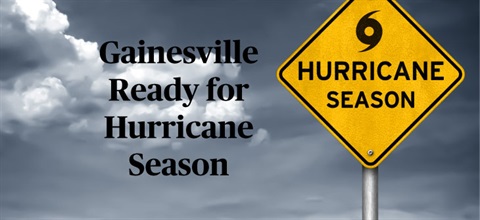Gainesville ready for hurricane season
Published on May 31, 2023

You can never be too prepared for hurricane season in Florida even if you live inland – just ask department heads and managers at the City of Gainesville who prepare their teams by reviewing processes, updating procedures and refreshing their skills in scenario-based trainings and exercises throughout the year.
Checklist items
Flashlight batteries, canned goods and bottled water may be first off the shelves as area residents purchase nonperishable foods and other storm supplies before the start of Atlantic hurricane season, June 1. For City of Gainesville departments, public service agencies and utilities, keeping inventory shelves stocked is vital to hurricane preparedness, response and recovery efforts. With supply chain pipelines slowed since the pandemic, the work begins months, and sometimes years, in advance.
For the Fleet Management team, which maintains and repairs 1,600 municipal vehicles throughout the year, there are two everyday items at the top of the storm season supplies checklist: windshield wiper blades and tires, lots of them.
“We’re stockpiling parts and topping off our fuel supplies,” said Fleet Director Jason Foster. “We make sure the bucket trucks, bulldozers and all vehicles are ready, so once a storm passes, response teams can head out to cut down trees and clear roads or replace utility poles,” he said.
There is no shortage of checklists.
“Because of extended supply-chain lead times, we had to order this year’s supply over a year ago,” said Barrie Corp, GRU supply chain manager. “We already have an order in for next year, and are working on the order for the 2025 storm season,” Corp said.
The Parks, Recreation and Cultural Affairs Department (PRCA) keeps a unique checklist for each municipal park, cultural center or recreational facility. A few days before a storm might impact the area, staff quickly mobilizes to secure picnic tables, umbrellas, chairs, screens and playground swings.
“We tie down anything and everything that could move or be torn away in winds over 35mph,” said PRCA Director Roxana Gonzalez. “After the storm has passed, we’ll look for trees that were damaged and branches that may still fall, and we’ll open the parks once we’ve secured the paths and trails as best we can.”
Storm systems that bring heavy rains to the area can test the pumps and drainage systems designed to direct stormwater away from residential areas into ditches, retention ponds and other basins.
“We work year-round conducting inspections and preventive maintenance in order to become more resilient,” said GRU Water/Wastewater Environmental Engineer Jennifer McElroy. “Each of our water treatment or reclamation facilities will house a team on-site 24/7 until the storm response is complete.”
Partnerships
In advance of storms, GRU Engineering staff coordinates with Alachua County counterparts to update floodwater mitigation plans and harden the wastewater collection system, for example.
Similarly, the city’s Solid Waste Division works with Alachua County to identify nearby debris sites long before named storms are on the horizon. These sites become the collection areas for a storm’s vegetative aftermath. Tree limbs and other yard waste collected throughout neighborhoods will be transported to the designated debris sites before being sent away and recycled as mulch.
Mutual aid agreements and other contracts that bring in external resources are key to any successful recovery effort.
“In the days prior to a storm, we plan for mutual aid needs, and adjust trucks and equipment – from being set up for construction activities – to being ready for storm work,” said Ray Jordan, GRU electric transmission and distribution manager. “We focus on maintaining relationships with our partners year-round to ensure that we will be able to receive mutual aid quickly as well as provide it as needed,” he said.
Getting prepared
The Public Works Department also may call on outside assistance after a major storm to help remove debris, and repair roads and infrastructure. One material kept well-stocked for both crews and local residents is sand. In advance of storm season, the team will stockpile 300 cubic yards of sand. Last September, that was enough to fill 32,000 sandbags for residents in advance of Tropical Storm Ian, with plenty of sand left over.
“We make sandbags available under two conditions,” explained Public Works Director Brian Singleton. “One, when a local state of emergency has been declared – and two, when a storm is forecast to bring sustained rainfall and regional flooding – but not if we’re only expecting lots of wind,” he said.
A maximum of 10 sandbags per vehicle is provided under these circumstances. The bags can help keep storm waters at bay when placed in front of an entry door or garage door. However, experts say the best way to be storm-ready is to have a disaster plan, evacuation plan and emergency kit prepared at the start of hurricane season.
“Start by printing out hard copies of insurance documents and other records you’d want to have with you if an evacuation order is issued,” said GFR District Chief of Emergency Management Sean Withers. “Keep those together with a go-kit full of items you’d need including clothing, medications, first-aid supplies, and food and water. There really is no time like the present to prepare for hurricane season,” he said.